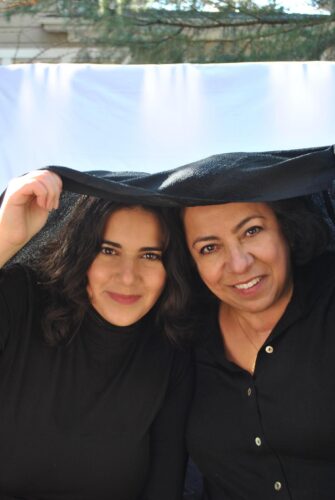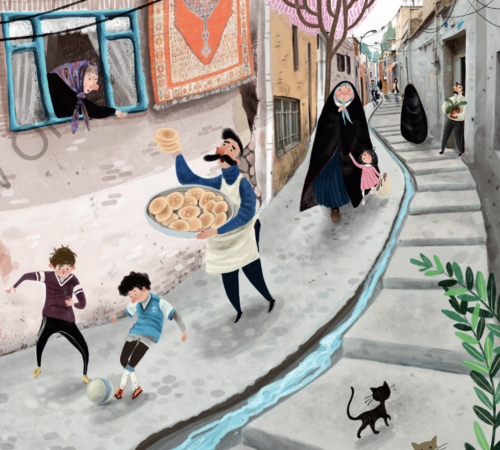A Beautiful Safe Space: Getting Into the Humor and Delights of Mama Shamsi at the Bazaar with Mojdeh Hassani and Samira Iravani
I was heartbroken.
It was a day near the end of 2022 and my library had just put the finishing touches on our 2022 101 Great Books for Kids list. It was, to be frank, a gorgeous collection of books and I was feeling mighty proud of it. I had gotten my mail and was breezing through a bunch of children’s books for 2023 when a particular title caught my eye:

Ooo! I don’t know what it was, but something about the cover just called to me. Maybe it was the grandmother’s expression, or the thick practical socks she’s wearing with her shoes. Maybe it was the way the granddaughter clings, both frightened and intrigued. Whatever it was, I opened it up and found myself so absolutely entranced. Here’s the write up I immediately made of it:
ADVERTISEMENT
ADVERTISEMENT
Set in Iran, the story follows little Samira as she gets to go to the bazaar with her grandmother for the very first time. Now this story could just be one of those books where the setting is the plot. Lots of those exist and they are, quite frankly, not always very interesting. This book, on the other hand, does this brilliant job of making you understand just how fun it is for a little kid to play under her grandmother’s big chador. Read the Authors’ Notes at the back and you realize that for kids with chador-clad grandmothers, this is a kind of universal way to play. In this particular tale, Samira gets increasingly nervous as she approaches the bazaar, so she keeps bugging Mama Shamsi to climb on her back or let her be behind, etc. Each time her grandma says no, pointing out what kind of animal they’d resemble if her granddaughter was under there. These authors actually managed to make the book rhyme rather well, giving the storyline a fun sing-song quality (ideal for storytimes, y’know). But one of the other huge lures is the art of Maya Fidawi who fills these pages with details like a zanbil, a Shahr-e-Farang, a joob, open canals that lines the roads, and more. Set unofficially at the Tajrish Bazaar at the end, it would make a really cool companion to the Raúl The Third book ¡Vamos! Let’s Go to the Market. Ideal too for those kids that like to visit markets, supermarkets, farmer’s markets, you name it.
I was so happy. 2023 was already going to be a great year if this was kicking it off. Then I flipped to the publication page and saw . . . 2022!!!!
Oh no! I’d missed it! How could this have happened?
The happy ending to this story is that the publication page was, I am pleased to say, wrongdy wrongdy wrong wrong wrong. Mama Shamsi at the Bazaar is out February 28th, making it absolutely 100% eligible for any 2023 lists you can name.
And you can understand why, when asked, I jumped at the chance to ask the book’s mother-daughter author duo, Mojdeh Hassani and Samira Iravani some questions about it. This is for those of you, like myself, who just wanted to know more.
Betsy Bird: Thank you both for joining me here today! I’m so pleased to be able to talk to you about the remarkable MAMA SHAMSI. I guess, right off the bat, I’d like to know the origin of the story. Who got the original idea? Where did it come from?

Mojdeh Hassani: I was speaking from my heart, from personal childhood experience. My grandmother, Mama Shamsi, liked to take me to run her errands which became some of the happiest memories I have of growing up in Tehran in ‘60s.
The idea to actually start writing this story came when I realized every time I saw women in black chadors on TV it was only in a negative or hateful context. My memories of my grandmother’s chador were of a beautiful and safe space, and I wanted everyone to have a chance to experience that.
BB: Often my favorite picture books are the ones that take some little element of childhood that people take for granted and put them on the page. The idea of playing in your grandmother’s chador makes complete sense, but I’ve never seen it in a book before. What made you think to include that element?
Samira Iravani: Because that’s exactly what we used to do! My mother did it with her grandmother in the 60s and 70s, and without even knowing that, as a child I also did that with my grandmother in the 90s. I always compare our story to little kids trying on mom or dad’s shoes and clomping around for fun, pretending to be grown up. That was exactly the invitation the chador gave us. When you share space as a child with someone who wears hijab, something like the chador is just as tempting to play with as shoes… I would say even more so, because here you have a giant, light, piece of fabric that you can shape and contort any way you like. Endless fun!
MH: Sammie used to jump under her grandmother’s chador even when she was praying! Prayer time is meant to be a time of sacred solitude, and all Muslims know you’re not supposed interrupt or even walk in front of someone who’s praying. But that never stopped Samira!
BB: One thing that allows the book to stand out in the field is right there in its description. It’s a fun picture book set in Iran. Normally, picture books set in countries, particularly Middle Eastern countries, and that are published in the States are dour and dire and generally depressive. There’s such light and joy to MAMA SHAMSI. Could you talk a bit about putting humor into a book like this?

SI: It’s very important to us that the image people have in their minds of Iran isn’t monolithic. Iran has experienced so many eras of peace (including the time period my mother grew up in), and the country is so full of beautiful and diverse people and spaces. It would be a shame if the only things young readers perceive of Iran is what appears in the news or in film and television where Iranians (and especially Muslim Iranians) are the convenient villains. My mother’s childhood was filled with fun and delight, thanks to the tender and attentive care of Mama Shamsi, and we wanted young people to taste a slice of that happiness and joy with this book.
BB: The art of Maya Fidawi acts as a perfect complement to the playfulness of the storytelling. Were you aware of Maya’s art before she was attached to the project? What did you think of the final product?
ADVERTISEMENT
ADVERTISEMENT
SI: I hadn’t seen Maya’s portfolio before our first editor, Dana Chidiac, presented her to us. I was thrilled with how whimsical and tender her work was, and it was clear that family and her beloved home in Lebanon played a very important role in her art.
MH: We were lucky to be able to collaborate very closely with her, sending reference photographs and detailed notes about things that would make the book’s characters and settings come alive. Mama Shamsi’s appearance (down to the type of stockings and shoes she wore), every street sign, the joob and Shahr-e-Farang (more about these in our author’s note), and even the types of street food you see characters eating at the bazaar were all informed by us.

SI: We’re overjoyed by how it all turned out, and are so happy that the playfulness of the words we wrote is reflected in the images.
BB: Agreed! Finally, what do you have coming out next?
SI: My mom has endless ideas inspired by her childhood—there are so many important family members, like Mama Shamsi, that shaped the person she is today. I feel like every time I visit her she has another clever little story planned for us to work on together! Nothing’s done being written just yet, but hopefully you’ll see more of Mama Shamsi and Samira.
BB: Oh, the world definitely needs more Mama Shamsi books.
I just can’t thank enough Mojdeh and Samira joining me on this site today. You can, as I mentioned, pick up your own copy of Mama Shamsi at the Bazaar on February 28th. Thank you too to Karter Powell and the folks at Dial Books for Young Readers for the talk.
Filed under: Best Books, Best Books of 2023, Interviews
About Betsy Bird
Betsy Bird is currently the Collection Development Manager of the Evanston Public Library system and a former Materials Specialist for New York Public Library. She has served on Newbery, written for Horn Book, and has done other lovely little things that she'd love to tell you about but that she's sure you'd find more interesting to hear of in person. Her opinions are her own and do not reflect those of EPL, SLJ, or any of the other acronyms you might be able to name. Follow her on Twitter: @fuseeight.
ADVERTISEMENT
ADVERTISEMENT
SLJ Blog Network
Name That LEGO Book Cover! (#53)
K is in Trouble | Review
Fighting Public School Book Bans with the Civil Rights Act
Take Five: Middle Grade Anthologies and Short Story Collections
ADVERTISEMENT







